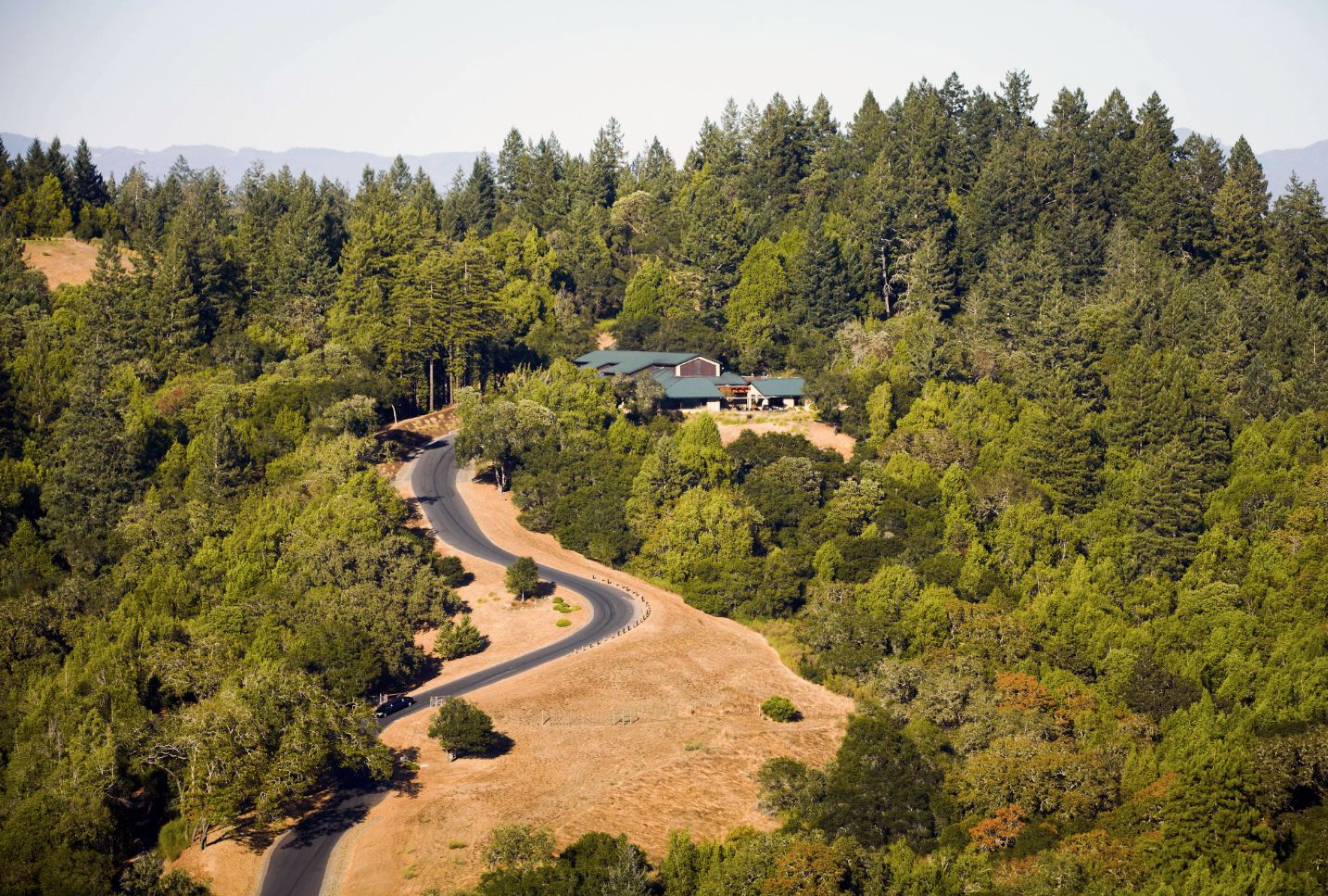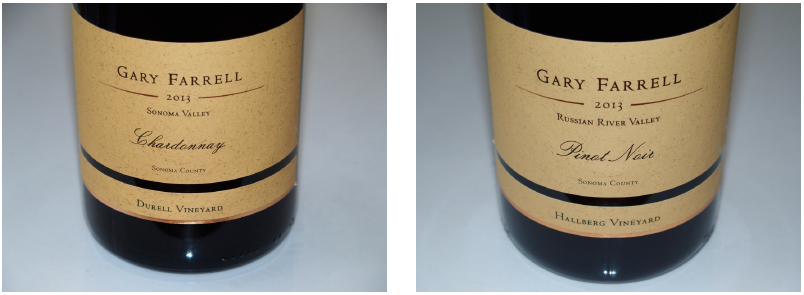2016 Winery of Year: Gary Farrell Vineyards & Winery
Blessed with a diverse palate of vineyards culled by Gary Farrell’s years of personal relationships with
legendary growers in the Russian River Valley dating back to the early 1980s, and embracing as well as
embellishing the Gary Farrell house style, winemaker Theresa Heredia has guided Gary Farrell Vineyards &
Winery to the forefront of California’s elite group of distinguished Pinot Noir and Chardonnay producers. She
has so impressed me with her accomplishments over the last three vintages, that I chose the Gary Farrell
Vineyards & Winery my 2016 Winery of Year.
Gary Farrell was a pioneering winemaker whose eponymous label brought Russian River Valley Pinot Noir into
prominence. After developing his winemaking skills during the mid-1970s working in the cellars of Tom
Dehlinger, Robert Stemmler and Davis Bynum, he started his own label, Gary Farrell, in 1982, and the same
year made the inaugural Pinot Noir for Rochioli Vineyard & Winery, trading winemaking for grapes from
Rochioli West Block and Allen Vineyard for his own inaugural release.
Farrell’s production under his own label had increased to 11,000 cases, outgrowing the facility at Davis Bynum
Winery where he made his wines, and he partnered with financier Bill Hambrecht to build an architecturally
stunning winery on Westside Road (pictured below).
In 2004, he sold his label and winery to Allied Domecq. The winery’s management subsequently passed
through corporate owners Beam Wine Estates and then Ascentia Wine Estates. Unhappy practicing his art
under corporate ownership, Farrell left Gary Farrell Winery in 2006, and started a small artisan label, Alysian
Wines. He chose Susan Reed, who had worked with him for four years, to succeed him as winemaker. On
May 1, 2012, Theresa Heredia replaced Reed as winemaker, and the winery moved into a new era of success
while still honoring the legacy of Gary Farrell who is now retired from winemaking.
Vincraft bought Gary Farrell Vineyards & Winery from Ascentia in April 2011, sold its majority share in Kosta Browne to JW Childs in January 2015, and disbanded in September 2015. Today, Gary Farrell Vineyards & Winery is owned by a group of investors (some of whom happen to have been the founding members of Vincraft), including Bill Price, the managing partner of Kistler Vineyard and owner of Three Sticks, Lutum and the Durell and Gap's Crown Vineyards, Pete Scott, the former CFO of Beringer Wine Estates and Walt Klenz, former President and CEO of Beringer Wine Estates. The current ownership is not content with the status quo, and always strives to push
Theresa and her staff to higher levels of quality. Production is gradually expanding to 30,000 cases (but not
beyond) as new elite grape sources are acquired within the Russian River Valley.
Theresa Heredia was an accomplished winemaker when I made her acquaintance several years ago while she
was the Winemaker at Phelps' new Freestone Winery. She was the Associate Winemaker under Craig Williams from 2005 to 2007 (Williams was the Director of Winemaking for Phelps), and when Williams retired in 2008, she was promoted to Winemaker and poured her heart into that position from 2008 to 2011. The modern Freestone winery, owned by Joseph
Phelps, had considerable resources, and allowed her the opportunity to experiment with a number of leading
edge winemaking techniques. She responded by crafting some remarkable Pinot Noir and Chardonnay wines
that really caught my attention.
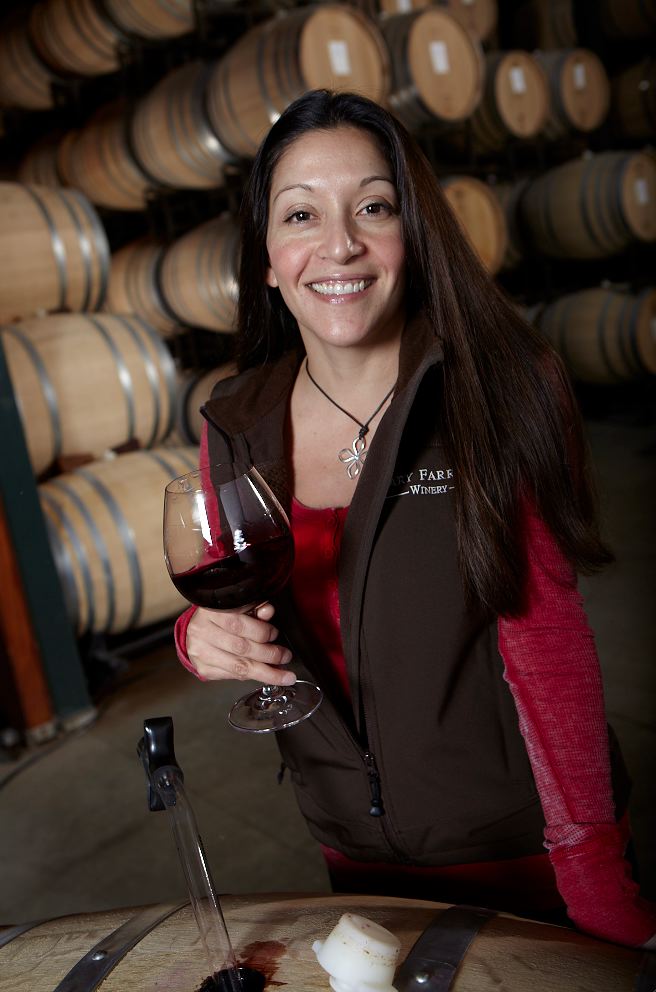
Theresa was raised in Pittsburg, California and attended Cal Poly San Luis Obispo where she majored in
chemistry. While apart of the chemistry doctorate program at University of California at Davis, she found that
the ongoing research in enology and viticulture was more interesting than the research in the Chemistry
Department, and she switched to the Enology & Viticulture program. In addition, she had developed an interest
in wine both at Davis and during travels in the wine regions of Europe.
Her first job in the wine industry was as a harvest intern at Saintsbury in Carneros. She was then hired as an
enologist at Phelps that eventually led to her winemaking position at Freestone Vineyards.
I asked Theresa about the challenges she faced when she first arrived at Gary Farrell Vineyards & Winery.
With a multitude of vineyard sources and many wines in the portfolio, it seemed to be a daunting task. She told
me that luckily the assistant winemaker had been at the winery for eleven years and the enologist for several
years so the staff was experienced in the winery operations. In addition, Nancy Bailey rejoined Gary Farrell
Vineyards & Winery as General Manager. She had worked with Gary Farrell, the man, from 2005 to 2006 in the capacity of Brand Manager for the Beam Wine Estates Pinot Noir portfolio. The opportunity arose in November 2011 to return to Gary Farrell Vineyards & Winery in the role of General Manager and she jumped at the chance, knowing how much untapped potential there was still to be realized. When Theresa
arrived in May 2012, the 2011 wines were in barrel and she was able to taste through the wines to familiarize
herself with the many different vineyard sources. Her first vintage in charge from harvest to bottling was 2012.
Theresa initially found the wines to be clean and crisp, but shared many similarities and lacked some
inspiration. The winemaking regimen tended to strip the wines of character. The wines were being sent to
barrel immediately after primary fermentation, racked off the lees once, and pad filtered. The wines were all
aged the same, in medium toast cooperage that was not tailored to individual wine sources.
Theresa instituted a number of Pinot Noir winemaking techniques for the better that were “feathered” into the
process through subsequent vintages. These changes included (1) Acquisition of an additional vibrating sorting
table, (2) Air conditioning in the barrel room to prevent evaporation leading to lower finished ABV, (3) Use of a
basket press instead of a bladder press improving the quality of the press wine, (4) Native yeast fermentations,
(5) Saignée to add depth, (6) Addition of a modest percentage (9%-22% in 2012) of whole cluster to contribute
tannin, backbone and spice, (7) Employing some ferments in 5-ton oak tanks that allow warmer, natural
ferments and gentler extraction, (8) Institution of extended maceration to enhance mouthfeel and alter aromatic
esters and tannins (Theresa would say, “At the end of fermentation there is ‘grape juice’ but at the end of
extended maceration there is ‘wine,’”) (9) No racking. Leaving the wine on the lees acts as a preservative and
preserves the wine’s character, (10) Tailoring the cooperage and toast to specific vineyards, (11) Discontinued
filtering of the wines, (12) Gradual use of an increased number of large oak puncheons (500 Liter) for
Chardonnay that offer less oak surface area, and (13) Use of concrete eggs as an added tool in vinification of
Chardonnay and Sauvignon Blanc. The single vineyard Pinot Noir wines are made only from 100% free-run
juice. The wines are aged typically for 15 months (10 months in the case of the Russian River Valley Selection
Pinot Noir) in 40%-50% new French oak barrels.
Chardonnays are fermented in French oak barrels (40% new) from several Burgundian cooperages, undergo
full malolactic fermentation, and aged on their yeast lees, with weekly stirring during malolactic fermentation
and monthly thereafter for seven months before bottling.
The result is that the Gary Farrell wines still retain food-friendly acidity that has been a hallmark of the Gary
Farrell Style, but they have more extraction, more complexity and more textural interest. Theresa has infused the lineup of wines with a stylistic stamp that makes them distinctive as a whole, without sacrificing, and even embellishing, the vineyard identity of each singular wine.
A newer series of small lot unique wines introduced with the 2011 vintage reflect the “inspiration” of the
winemaker and are bottled with black labels as the Inspiration Series. One of these wines, the 2014 Love in the
Time of Calera Pinot Noir produced using Calera selections from Fort Ross and Martaella vineyards, was one
of my top scoring All-Americans this year. Some of this wine was vinified with 50% whole cluster in an oak tank,
and some was vinified with 30% whole cluster in stainless steel (70 cases, $70, available to Wine Club
members only).
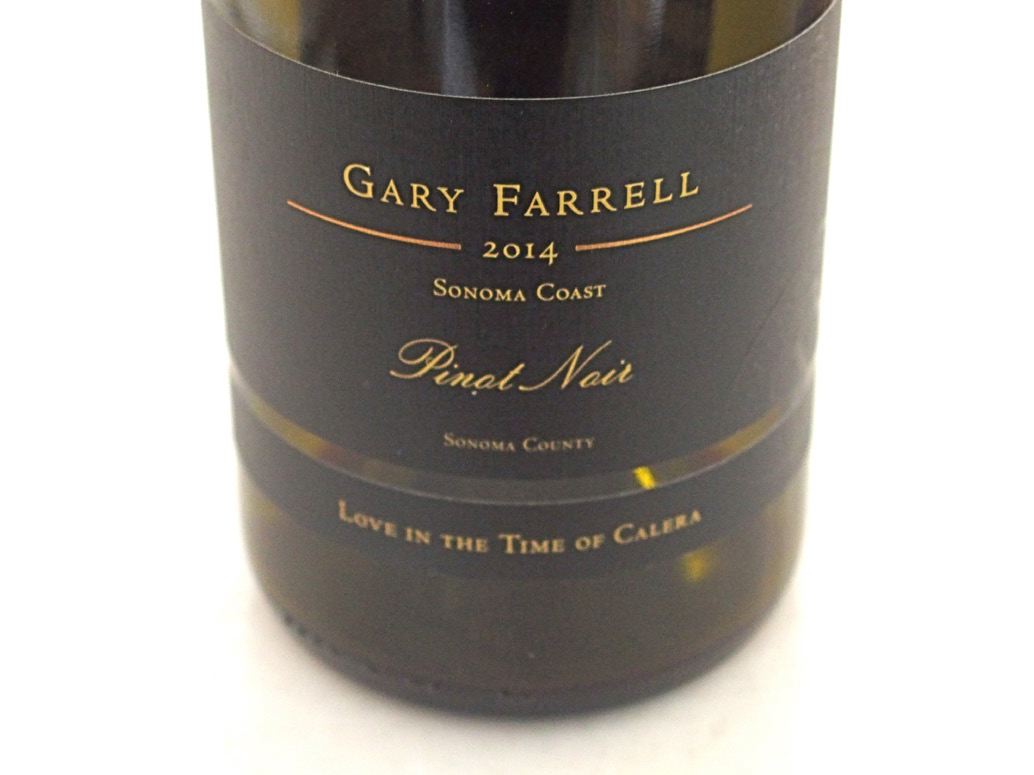
An interactive Russian River Valley vineyard map showing many of the winery’s vineyard sources is offered on
the winery website at www.garyfarrellwinery.com. The list of elite vineyards that supply grapes to Gary Farrell
Vineyards & Winery is extensive, with names like Rochioli River Block and Allen, Bacigalupi, Martinelli Lolita
and Parnell Ranch, Martaella, Pellegrini Olivet Lane Estate, Stiling, Ritchie, Westside Farms, Lancel Creek,
Hallberg, Dutton Ranch Wat, Toboni, Emeritus McDonald Mountain, and Pratt Cornerstone. Vineyards outside
the Russian River Valley include Durell in Sonoma Valley, Fort Ross in Fort Ross-Seaview Sonoma Coast,
Gap’s Crown in Sonoma Coast and Bien Nacido in Santa Maria Valley. There are very few producers of
California Pinot Noir and Chardonnay that can lay claim to such an extensive array of top notch vineyard
sources. Below is the map in a non interactive form.
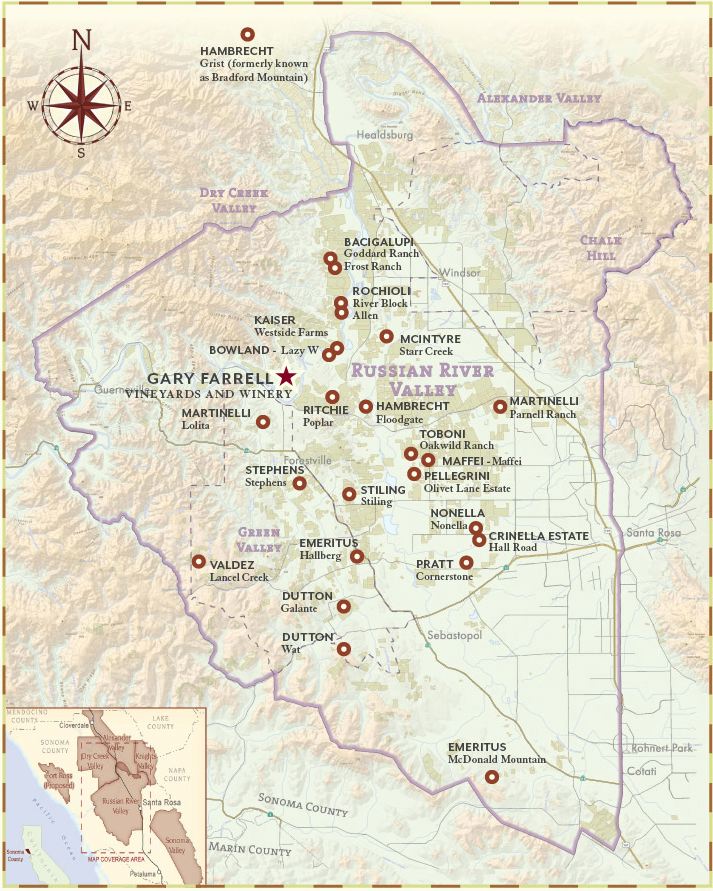
I have reviewed nearly every Pinot Noir and Chardonnay that Theresa has crafted from the 2012, 2013 and
2014 vintages. She blended the 2011 vintage but did not vinify the wines that year. A summary of some of the
scores I awarded will give you an idea of the high quality of the wines.
Gary Farrell Rochioli Vineyard RRV Pinot Noir: 2012 93, 2013 93, 2014 94-95
Gary Farrell Rochioli-Allen Vineyards RRV Pinot Noir: 2012 90, 2013 94
Gary Farrell Toboni Vineyard RRV Pinot Noir: 2012 90, 2013 96, 2014 94
Gary Farrell Hallberg Vineyard RRV Pinot Noir: 2012 92, 2013 92, 2014 93
Gary Farrell Bien Nacido Vineyard SMV Pinot Noir: 2012 92, 2013 94, 2014 92
Gary Farrell Rochioli Vineyard RRV Chardonnay: 2012 90, 2013 93, 2014 94
Gary Farrell Rochioli-Allen Vineyards RRV Chardonnay: 2012 90, 2013 92 (Oak Puncheon 93), 2014 92
Gary Farrell Bacigalupi Vineyard RRV Chardonnay: 2012 91, 2013 90, 2014 94
Gary Farrell Durell Vineyard Sonoma Valley Chardonnay: 2012 89, 2013 92, 2014 91
Of the 60 Gary Farrell wines crafted by Theresa from the 2012, 2013 and 2014 vintages that I have reviewed,
only 8 wines received less than a score of 90 and 6 of those scored 89. 11 wines received a score of 94 or
above. This is a testament to consistent quality. You will also notice that the wines have improved in quality
each year over the three vintage span that Theresa has been responsible for the wines. Reviews of Gary
Farrell Vineyards & Winery wines can be found at www.princeofpinot.com/winery/420/.
The tasting room and terrace at Gary Farrell Vineyards & Winery is currently undergoing renovation to better
accommodate guests. Guests are welcome in the meantime by appointment in new “glamping cottages”
adjacent the winery. Reservations can be made online or by phoning 707-473-2909, or contacting
concierge@garyfarrellwinery.com. Refer to the winery website for tasting options. Members of the Grand Crew
Club have guaranteed access to small-lot wines, pre-release access to the entire Gary Farrell portfolio and
special benefits when visiting the winery. Visit www.garyfarrellwinery.com for details.



